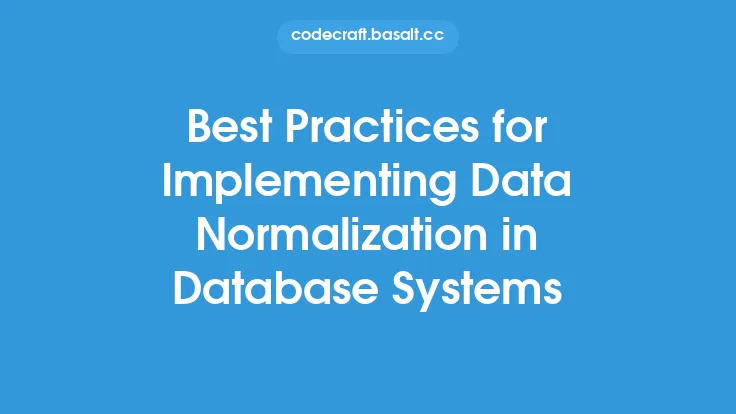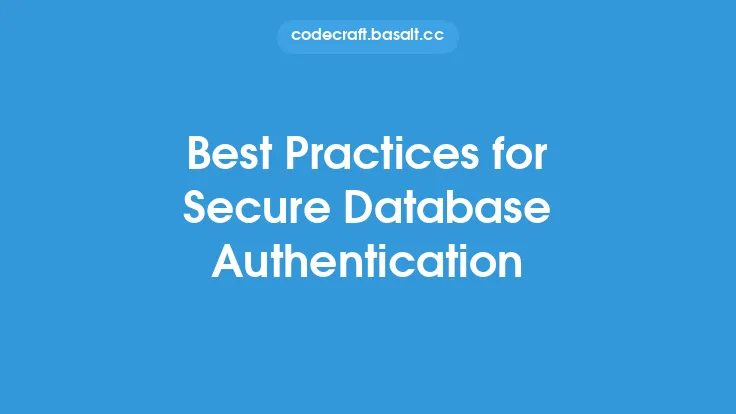Managing data storage in cloud-based database systems is a critical aspect of ensuring the overall performance, scalability, and reliability of an organization's data infrastructure. As more businesses move their data to the cloud, it's essential to adopt best practices for managing data storage to maximize the benefits of cloud computing while minimizing potential risks. In this article, we'll explore the key considerations and strategies for effective data storage management in cloud-based database systems.
Introduction to Cloud-Based Database Systems
Cloud-based database systems offer a range of benefits, including scalability, flexibility, and cost-effectiveness. These systems allow organizations to store and manage large amounts of data in a remote, cloud-based environment, reducing the need for on-premises infrastructure and maintenance. However, cloud-based database systems also introduce new challenges, such as data security, compliance, and performance optimization. To address these challenges, organizations must adopt a comprehensive approach to data storage management that takes into account the unique characteristics of cloud-based database systems.
Data Storage Options in Cloud-Based Database Systems
Cloud-based database systems offer a range of data storage options, including relational databases, NoSQL databases, and object storage. Relational databases, such as Amazon RDS and Google Cloud SQL, provide a structured approach to data storage, with support for SQL queries and transactions. NoSQL databases, such as Amazon DynamoDB and MongoDB, offer a flexible, schema-less approach to data storage, with support for high-performance, distributed data processing. Object storage, such as Amazon S3 and Google Cloud Storage, provides a scalable, durable approach to storing unstructured data, such as files, images, and videos. When selecting a data storage option, organizations should consider factors such as data structure, query patterns, and performance requirements.
Data Storage Management Strategies
Effective data storage management in cloud-based database systems requires a combination of strategic planning, monitoring, and optimization. One key strategy is to implement a data classification system, which categorizes data based on its sensitivity, criticality, and retention requirements. This allows organizations to apply appropriate security, compliance, and storage policies to each data category. Another strategy is to use data compression and encryption to reduce storage costs and protect sensitive data. Additionally, organizations should implement data backup and recovery processes to ensure business continuity in the event of data loss or corruption.
Performance Optimization Techniques
Performance optimization is critical in cloud-based database systems, where data storage and processing can have a significant impact on application performance. One technique is to use indexing and caching to improve query performance, reducing the need for disk I/O and minimizing latency. Another technique is to implement data partitioning and sharding, which distribute data across multiple storage devices and nodes, improving scalability and reducing contention. Organizations should also monitor performance metrics, such as latency, throughput, and disk utilization, to identify bottlenecks and optimize data storage and processing.
Security and Compliance Considerations
Security and compliance are essential considerations in cloud-based database systems, where sensitive data is stored and processed. Organizations should implement robust security controls, such as access controls, authentication, and authorization, to protect data from unauthorized access. Additionally, organizations should comply with relevant regulations, such as GDPR, HIPAA, and PCI-DSS, which govern data privacy, security, and retention. To ensure compliance, organizations should implement data encryption, access logging, and audit trails, and regularly review and update their security and compliance policies.
Cost Management and Optimization
Cost management and optimization are critical in cloud-based database systems, where storage and processing costs can quickly add up. One strategy is to use cost-effective storage options, such as object storage, for infrequently accessed data. Another strategy is to implement data lifecycle management, which automates the migration of data to lower-cost storage tiers based on its age, usage, and retention requirements. Organizations should also monitor storage usage and costs, and optimize their data storage and processing configurations to minimize waste and reduce costs.
Monitoring and Troubleshooting
Monitoring and troubleshooting are essential in cloud-based database systems, where performance issues and errors can have a significant impact on application availability and user experience. Organizations should implement monitoring tools, such as Amazon CloudWatch and Google Cloud Monitoring, to track performance metrics, detect anomalies, and receive alerts and notifications. Additionally, organizations should implement troubleshooting processes, such as log analysis and error tracking, to identify and resolve issues quickly and efficiently.
Best Practices for Data Storage Management
To ensure effective data storage management in cloud-based database systems, organizations should adopt the following best practices:
- Implement a data classification system to categorize data based on its sensitivity, criticality, and retention requirements.
- Use data compression and encryption to reduce storage costs and protect sensitive data.
- Implement data backup and recovery processes to ensure business continuity in the event of data loss or corruption.
- Monitor performance metrics, such as latency, throughput, and disk utilization, to identify bottlenecks and optimize data storage and processing.
- Implement robust security controls, such as access controls, authentication, and authorization, to protect data from unauthorized access.
- Comply with relevant regulations, such as GDPR, HIPAA, and PCI-DSS, which govern data privacy, security, and retention.
- Use cost-effective storage options, such as object storage, for infrequently accessed data.
- Implement data lifecycle management to automate the migration of data to lower-cost storage tiers based on its age, usage, and retention requirements.
- Monitor storage usage and costs, and optimize data storage and processing configurations to minimize waste and reduce costs.
By adopting these best practices and strategies, organizations can ensure effective data storage management in cloud-based database systems, maximizing the benefits of cloud computing while minimizing potential risks.





